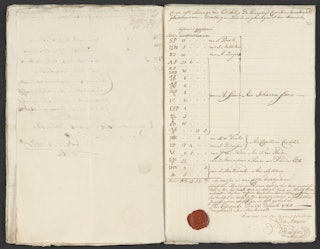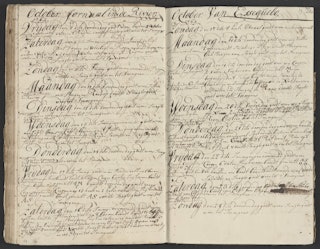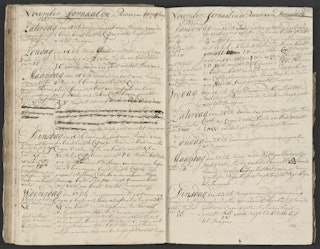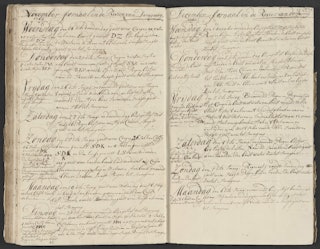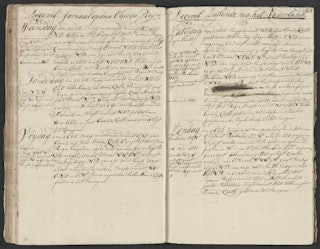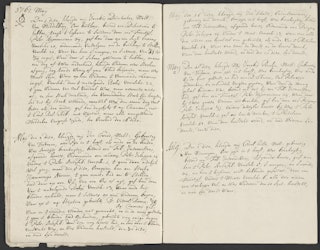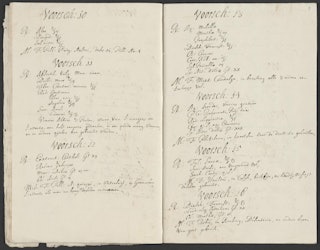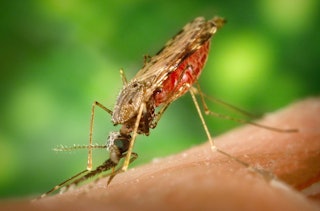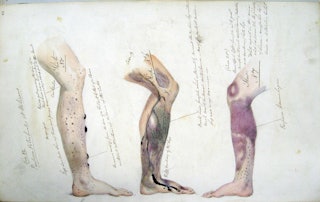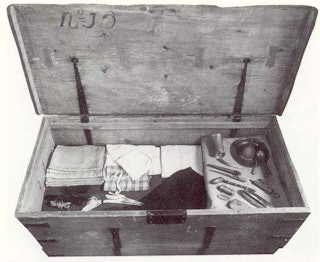6.1 New cargo and preparations for the return voyage
Introduction
The delivery of the return cargo was awaited in the Demerary river. During the six-week stay in Demerary the crew had little to do. Most of the necessary repairs had been made to The Unity while in the Essequibo colony. The sails were aired regularly, the anchor ropes were mended and firewood was chopped. In November 1762 barrels and bags of sugar, coffee and other products from the plantations were brought on board. A bag of letters was also taken along, with letters from the colonists to their families in the Netherlands. Lastly water barrels were brought on board and the ship was ready for departure.
Documents
Worksheets
- Introduction Lesson 6.1 New cargo and preparation for the return voyage
- Lesson 6.1 New cargo – Math
- Lesson 6.1 New cargo – Language
- Lesson 6.1 New cargo – WO
Extra
Viewing assignment – film (internet)
Warning: Some images shown can be experienced as shocking.
The Klokhuis episode De slavernij junior : Suiker (Slavery Junior: Sugar), Episode 2; 20:00 min.; Dutch spoken, subtitles available in various languages. Click ‘subtitles’ in the bottom right-hand corner and move the arrow to ‘Translate subtitles’. Select a language and click OK.
This short film is about slavery and sugar. Sugar is mostly used as a sweetener. Sugar is extracted from sugar cane. During the 17th-19th century this was cultivated on plantations in the colonies. Enslaved Africans worked on the plantations. The work on the sugar plantations was heavy and dangerous. The slaves were fed little and if the master thought they did something wrong, they were often punished severely. Some tried to escape and sometimes they succeeded. The Netherlands did not abolish slavery until 1863. Three Dutch boys have explored slavery and what they experience about it in their lives. They talk about slavery and write a rap song about it, which they perform during Keti Koti Day, the annual commemoration for the abolition of slavery and the feast of the broken chains.
Watch the episode about slavery and sugar and the make the assignment.
Assignment:
- Discuss the film in class. What did you think of this episode? Did it give you an idea of what life was like on the plantations and how difficult life was for the enslaved Africans? What image or scenes stayed with you the most and why? Take notes on what you discussed.
- The boys in the film discuss slavery together and they write a rap about how bad it was, how it is now and what they think about it. Could you write a rap about slavery? Make groups of three, four or five students and think about what should be in the song. Should it just be about the past and how bad it was, or also about now, and about what you can still notice from the legacy of slavery? And it is good to mention something about the shared history, that all people can talk to each other and organize activities to promote respect for one another? Use the notes you have taken for assignment 1.
- Present your rap to the group or class. If possible, you and your teacher can see if you can perform the rap during a school event or a special school day. Or perhaps, if your country has a Keti Koti Day, or another appropriate festive- or memorial day, you can ask your teacher if you and/or your class can perform the rap there.
6.2 At sea and settlement
Introduction
During the entire voyage persons aboard The Unity were given free medical care. The surgeon brought medicine and surgical instruments; he was required to have his chest inspected by an official inspector of the Middelburg Commerce Company. Common ailments on the ship were: scurvy, diarrhea, dysentery and fever/malaria. Prior to departure the trunk was inspected and carefully sealed. The surgeon was given the key and was responsible for the content of the trunk during the voyage. The Unity began her voyage home on medio December 1762. After more than three months The Unity sailed into the Middelburg harbor.
Documents
Worksheets
- Introduction Lesson 6.2 Homeward voyage
- Lesson 6.2 At sea and settlement – Math
- Lesson 6.2 At sea and settlement – Language
- Lesson 6.2 At sea and settlement – WO
Extra
Archival research aided by the Internet
This assignment for young archival researchers is about making connections between documents. By comparing different documents about the same event or the same subject with each other, you can discover how, why and when something occurred. Archival research is like detective work!
In the MCC archives you will find various documents. Including all the documents about the voyage taken by The Unity. Many of these documents are on the MCC Slave Voyage The Unity website. This assignment is about disease aboard The Unity.
Assignment
Have a look at the report by the ship’s surgeon in his journal on November 18, 1761. In this he reports that third mate Adriaan de Puit (also written Arriaan de Puijt) comes to see him with an ailment. The surgeon writes down what his diagnosis is, what medications he prescribes and if it helps.
Have a look at the report by the ship’s surgeon in his journal on December 12, 1761. This is also about Adriaan de Puit. The surgeon describes what has happened to Adriaan de Puit between November 18th and December 12th.
Have a look at the report by the ship’s surgeon in his journal on August 13, 1762. This is about a female African slave. Her name is not mentioned, the surgeon simply indicates her in his journal as ‘female slave’. In his journal she is number 33. The surgeon writes down what the ailment is and what medication he gives her.
Have a look at the report by the ship’s surgeon in his journal on August 18, 1762. In it he writes that ‘female slave no. 33’ still has the same ailment and what other medicine he gives her.
Have a look at the report by the ship’s surgeon in his journal on August 19, 1762. This is also about the female slave. The surgeon describes what happened to this slave between August 13th and August 19th.
Answer the following questions:
- Adriaan de Puit and the African woman both came to see the surgeon with the same ailment. What was this?
- From the surgeon’s journal we can guess approximately what age Adriaan de Puit and the African woman were. From the text can you estimate how old or young they were?
- What is the difference between the treatment given to Adriaan de Puit and the African woman?
- Do you see similarities in the treatment of Adriaan de Puit and the African woman?
- After taking laxatives (medicine to stimulate the defecation), both pooped something out that healthy people do not poop out. What was this?
- Describe how things ended for Adriaan de Puit and the African woman.
- What do you think: What played a role in the outcome of the two case histories: the age of the afflicted, their general wellbeing, the treatment of the circumstances? Or a combination of two or more factors? Explain why you think this.

